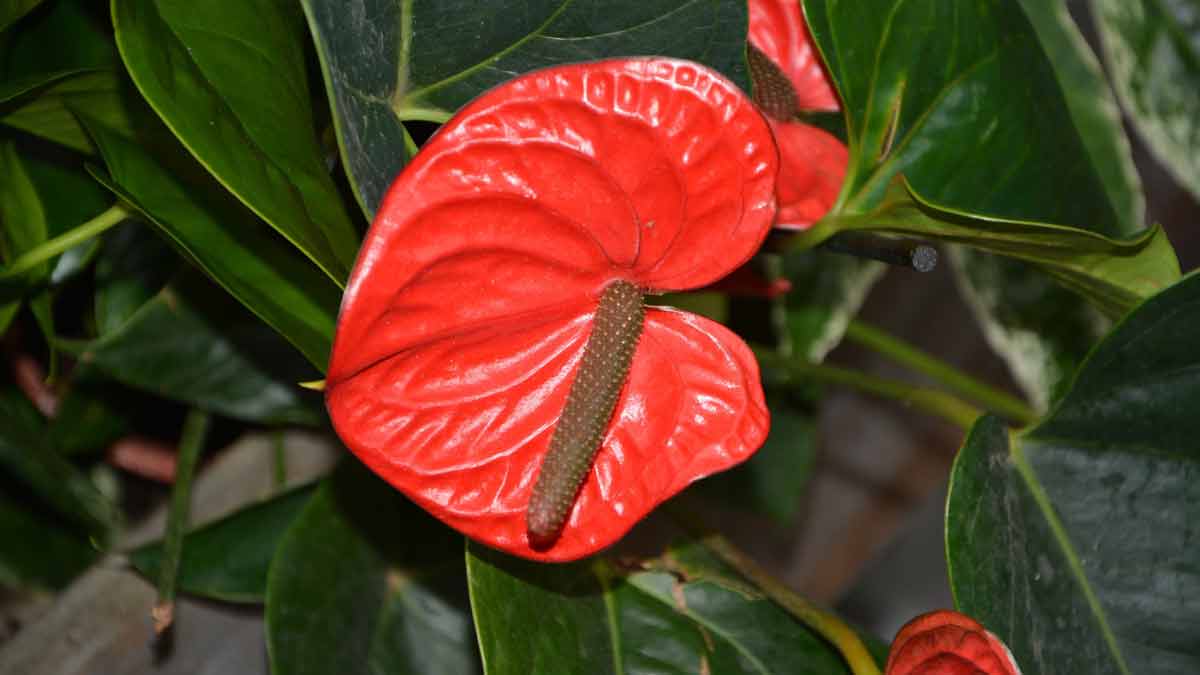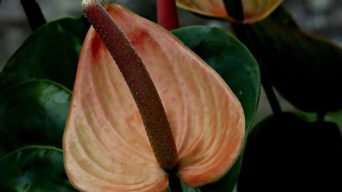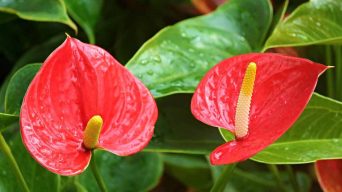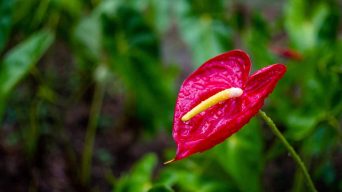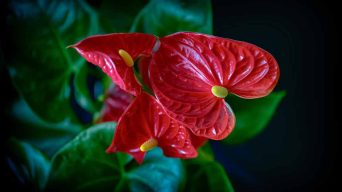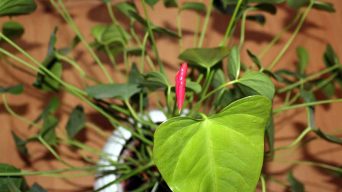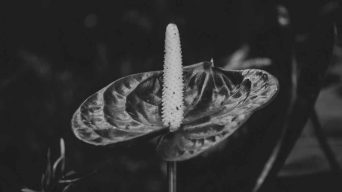Brown spots on anthurium leaves can be caused by various factors such as overwatering, nutrient deficiencies, direct sunlight exposure, and bacterial diseases. Identifying the root cause and taking appropriate measures, such as adjusting watering frequency, providing proper lighting, and applying fertilizers, is important.
Indoor gardeners cherish Anthurium plants for their vibrant, long-lasting blooms and lush green foliage.
But when you notice discolored leaves with alarming brown spots taking over your favorite tropical plant, it’s time to take action!
Discover the common causes of these unsightly blemishes and learn practical solutions to restore your Anthurium’s health in this informative guide.
Causes Of Brown Spots On Anthurium Leaves
Brown leaf spots on Anthurium plants can be caused by various factors such as overwatering, underwatering, inadequate lighting, nutrient deficiencies, bacterial leaf blight, and pest infestations.
Identifying the underlying cause of brown spots is crucial to take appropriate remedial measures and preventing further plant damage.
1. Overwatering
Overwatering is a common cause of brown Anthurium leaves and can lead to various issues, including root rot.
Being native to tropical rainforests, these plants prefer consistent moisture but are highly susceptible to overwatering problems due to their delicate root systems.
When the plant receives too much water, it may develop symptoms such as soggy brown leaves.
To prevent overwatering, it’s essential to maintain proper care routines and monitor your plant closely.
2. Underwatering
One common cause of brown leaves is underwatering.
While Anthurium plants are known for being relatively low-maintenance and adaptable to various conditions, they still depend on consistent moisture levels in the soil to stay healthy.
Underwatering can result in the plant receiving inadequate nutrients from the potting mix, leading to stress and issues such as leaf spot.
To identify if underwatering may be the source of your Anthurium leaves turning brown, examine the plant closely for additional signs such as yellowing leaves or drooping foliage.
Signs that your anthurium houseplant needs more water might include crisp, dry edges along the margins of multiple leaves or root rot due to roots drying out excessively between watering sessions.
3. Improper Lighting
Improper lighting is a common cause of brown leaves, often leaving plant enthusiasts puzzled about their beloved plants’ health.
Anthurium plants thrive in bright, indirect light – making them perfect for indoor spaces with abundant natural sunlight but not direct exposure to the sun’s harsh rays.
Direct sunlight can scorch the delicate leaves and lead to unsightly brown spots or even yellowing across entire leaf surfaces.
4. Nutrient Deficiency
If your Anthurium plants show brown flowers or leaves, one potential cause could be nutrient deficiencies.
Specifically, a lack of nitrogen, potassium, or magnesium can lead to discoloration and spotting.
This often happens when the plant is not receiving enough fertilizer with the right balance of nutrients.
5. Bacterial Leaf Blight
One of the most common causes of black and brown spots on plant leaves is bacterial leaf blight, caused by bacteria that infects the leaves.
These bacteria can quickly spread and cause significant damage to your plant.
The symptoms of bacterial leaf blight include dark brown or blackish spots on the leaves and yellowing and wilting.
6. Pest Infestations
Pest infestations can be a pesky cause of brown spots on Anthurium plants.
Bugs like scale insects and mealybugs can leave tiny, waxy bumps on plant leaves and stems that suck the sap from within, causing white spots, browning, or yellowing in affected areas.
Effective Ways to Address Brown Spots on Anthurium Leaves
If you’re struggling with brown spots on your Anthurium leaves, several solutions are available.
By adjusting lighting, watering, and fertilization, you can improve the overall health of your plant.
Additionally, treating bacterial leaf blight, pest infestations, and even transplanting to a new container may be necessary.
The following text will explore these solutions in more detail to help revive your Anthurium plant.
1. Adjusting Lighting Conditions
Adjusting lighting conditions is crucial in fixing brown leaves on Anthurium plants.
This is because too little or too much light can cause the plant to stress and lead to discoloration of the leaves.
Here are some tips for adjusting lighting conditions:
- Place the Anthurium in bright, indirect light: Direct sun exposure can scorch the delicate leaves of an Anthurium, so it’s best to place it in a location that receives bright but indirect light.
- Rotate the plant regularly: Rotating the plant every few days ensures that all sides of the Anthurium receive even amounts of light. This can prevent one side from becoming overexposed and causing brown spots.
- Use artificial lighting: If natural light is insufficient, you can supplement it with artificial lighting that provides wavelengths similar to sunlight.
- Avoid sudden temperature changes: Maintaining temperatures around your Anthurium at a consistent level is essential for its health . Sudden temperature changes can stress plants and cause leaf yellowing or brown leaf tips.
2. Regulating Watering
To prevent the occurrence of brown leaves, it is crucial to regulate watering correctly.
Here are some tips to consider:
- Avoid overwatering the plant, leading to root rot and fungal growth.
- Ensure that the soil drains well and does not become waterlogged.
- Water the Anthurium plant only when the top inch of soil feels dry, using room temperature or tepid water.
- Use a container with drainage holes to allow excess water to escape.
- Avoid letting the plant sit in standing water.
- Consider using a moisture meter to check soil moisture levels and only water when necessary.
By regulating watering habits, you can prevent brown leaves caused by overwatering or underwatering and promote healthy growth for your tropical plant.
3. Proper Fertilization
Proper fertilization is crucial for the healthy growth of anthurium plants.
Here are some tips to ensure your anthurium plant receives the correct amount of nutrients it needs:
- Use a balanced fertilizer: Anthurium plants require a balanced fertilizer that contains equal amounts of nitrogen, phosphorus, and potassium. A 20-20-20 ratio is ideal.
- Fertilize once a month: Apply fertilizer once a month during the growing season (spring and summer). Avoid over-fertilizing, as this can cause brown tips on the leaves due to salt buildup in the soil.
- Dilute the fertilizer: Always dilute the fertilizer with water to half-strength before application. This will prevent the burning of Anthurium roots and leaves due to high concentration.
- Apply at the base of the plant: Apply fertilizer at the base of the plant rather than on top of its foliage. This ensures that it reaches its roots directly.
- Monitor for changes: Observe your anthurium plant after fertilization for any changes or improvements in growth and color.
Following these steps will help ensure your anthurium plant receives proper nutrition, leading to healthy growth and vibrant foliage without brown spots.
4. Treating Bacterial Leaf Blight
Bacterial leaf blight is a common disease that water-soaked spots, yellowing of leaves, and plant wilting can identify.
To treat bacterial leaf blight in anthurium plants, follow these steps:
- Remove affected leaves: Remove infected leaves using sanitized garden shears or scissors to prevent the disease from spreading.
- Apply fungicides: Apply copper-based fungicides to the affected areas of the plant. It is essential to use a proper fungicide suitable for Anthuriums and carefully follow the instructions on the label.
- Improve cultural practices: Improve cultural practices such as reducing humidity levels, providing good air circulation, and avoiding overwatering to prevent the further spread of bacteria.
- Quarantine infected plants: If you have multiple plants, quarantine the infected plant to avoid infecting other healthy plants in your collection.
- Monitor progress: Monitor your plant’s progress and continue treatment until there are no more signs of infection.
It’s important to note that prevention is key to avoiding bacterial leaf blight altogether.
Maintaining good hygiene practices and using balanced fertilizers can help keep your Anthurium plant healthy and free from infections.
5. Addressing Pest Infestations
Pest infestations can be a common cause of brown spots on Anthurium plants.
Here’s what you need to do to address it:
- Identify the pest: Examine the plant for any signs of pests, such as spider mites, mealybugs, or thrips.
- Isolate the infected plant: If you’ve confirmed that your Anthurium has a pest problem, isolate it from other plants to prevent further spread.
- Remove visible pests: Use a soft-bristled toothbrush or cotton swab dipped in rubbing alcohol to remove visible pests on the leaves and stems.
- Use insecticidal soap or neem oil: Apply insecticidal soap or neem oil according to package directions to kill any remaining pests.
- Repeat treatment if necessary: Check your plant regularly for any signs of new infestations and repeat treatment if necessary.
6. Transplanting to A New Container
Transplanting your Anthurium into a new container can help fix brown spots on its leaves.
Here are some tips for transplanting:
- Select a pot slightly larger than the current one to allow room for growth.
- Use fresh, well-draining soil to ensure the roots have access to proper nutrients and oxygen.
- Gently loosen the plant from its current container and remove any dead or damaged roots.
- Place the Anthurium in the new pot and fill it with soil, ensuring it is planted at the same depth as before.
- Water thoroughly, but be careful not to overwater, as this can lead to root rot.
Transplanting can also help prevent future issues with brown leaves by providing a fresh start in a clean container with healthy soil.
Remember to choose a pot with drainage holes and avoid overwatering or overfertilizing in the future.
Preventing Anthurium Leaf Browning
Several key factors must be considered to keep Anthurium leaves free from brown spots.
These include maintaining healthy soil and containers, avoiding excessive watering and fertilization, quarantining new plants, checking for pests and diseases, and quickly removing affected leaves.
By implementing these preventative measures, you can help ensure your Anthurium plants remain healthy and vibrant.
1. Proper Soil And Container Maintenance
Proper soil and container maintenance prevents brown leaves.
Here are some tips to keep your Anthurium plant healthy and vibrant:
- Use well-draining potting soil: Anthuriums prefer slightly acidic soil with good drainage. Avoid using heavy soil or garden soil, which can cause water to pool and lead to root rot.
- Choose the right container: Select a pot that is just slightly larger than the root ball of your plant. This will help prevent overwatering and promote healthy growth.
- Provide adequate drainage: Ensure your container has drainage holes to allow excess water to flow out of the soil.
- Repot as needed: Anthuriums may outgrow their containers over time, leading to crowded roots and poor growth. Repot your plant every 1-2 years to ensure healthy root development.
- Avoid overfertilizing: Too much fertilizer can cause salt buildup in the soil, leading to brown patches on leaves. Follow manufacturer recommendations for fertilizer use and avoid giving more than needed.
2. Avoiding Overwatering And Overfertilization
Overwatering and overfertilization are two of the most common causes of brown spots on Anthurium plants.
These issues can be avoided by paying attention to your plant’s watering and fertilizing needs.
To prevent overwatering, ensure the soil is moist but not soggy.
Water your Anthurium only when the top inch of soil feels dry.
It’s also essential to ensure proper drainage using a pot with drainage holes.
Overfertilization can cause excessive salts in the soil, leading to toxicity and brown leaves.
Use a balanced fertilizer every 4-6 weeks during the growing season, following package instructions for amounts per pot size or one-quarter strength recommended dosages for houseplants.
Avoid fertilizing during dormancy or winter months when growth slows down.
3. Quarantining New Plants
If you plan to add new Anthurium plants to your collection, it’s important to quarantine them before bringing them into contact with the rest of your plants.
This helps prevent the spread of pests and diseases that could harm your existing plant population.
Keeping new plants separate from others for a few weeks allows you to observe them closely and ensure they are healthy before introducing them into your collection.
During the quarantine period, watch for any signs of pest infestations or disease, such as brown spots on leaves or yellowing foliage.
If you notice any issues, address them promptly by treating affected areas.
4. Regular Inspections For Pests And Diseases
Regular inspections for pests and diseases are important in preventing Anthurium brown leaves.
Here are some tips to help with regular inspections:
- Check the underside of the leaves: This is where pests such as spider mites and scale insects tend to congregate.
- Look for any signs of discoloration or spotting: Brown spots can be a sign of bacterial blight or leaf spot, while yellow leaves can indicate nutrient deficiencies or root rot.
- Inspect new plants before bringing them home: Quarantine them for a few weeks to ensure they are not carrying any pests or diseases that could infect your other plants.
- Trim affected leaves: If you find any leaves already affected by pests or diseases, trim them off and dispose of them properly to prevent further spread.
- Maintain proper growing conditions: Providing your Anthurium plant with the right amount of water, light, and humidity can also help prevent pest and disease issues from arising in the first place.
5. Trimming Affected Leaves
It is important to trim affected leaves to prevent the spread of brown spots on leaves.
Here are the steps to do it properly:
- Use clean and sharp scissors or pruning shears.
- Cut off the affected leaf as close to the stem as possible without damaging other healthy leaves.
- If multiple leaves are affected, cut them all off at once.
- Dispose of the infected leaves properly by placing them in a sealed plastic bag before throwing them away.
- Disinfect your scissors or pruning shears after use, using rubbing alcohol or a solution made of 1 part bleach to 9 parts water.
Final Thoughts
If you want your Anthurium plant to thrive, it’s essential to be mindful of its needs.
Brown spots on the leaves can be a sign that something is wrong, but with careful attention and proper care, they can disappear over time.
Remember to regulate watering, adjust lighting conditions if necessary, watch for pests and diseases, and fertilize properly.
With determination and patience, you can save your precious Anthurium from brown leaf spots and make it look beautiful again.

